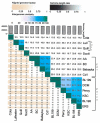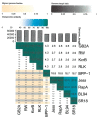New Genera and Species of Caulobacter and Brevundimonas Bacteriophages Provide Insights into Phage Genome Evolution
- PMID: 38675982
- PMCID: PMC11053796
- DOI: 10.3390/v16040641
New Genera and Species of Caulobacter and Brevundimonas Bacteriophages Provide Insights into Phage Genome Evolution
Abstract
Previous studies have identified diverse bacteriophages that infect Caulobacter vibrioides strain CB15 ranging from small RNA phages to four genera of jumbo phages. In this study, we focus on 20 bacteriophages whose genomes range from 40 to 60 kb in length. Genome comparisons indicated that these diverse phages represent six Caulobacter phage genera and one additional genus that includes both Caulobacter and Brevundimonas phages. Within species, comparisons revealed that both single base changes and inserted or deleted genetic material cause the genomes of closely related phages to diverge. Among genera, the basic gene order and the orientation of key genes were retained with most of the observed variation occurring at ends of the genomes. We hypothesize that the nucleotide sequences of the ends of these phage genomes are less important than the need to maintain the size of the genome and the stability of the corresponding mRNAs.
Keywords: Autographiviridae; Brevundimonas; Caulobacter; bacteriophages; genome comparisons; indels; new genera and species.
Conflict of interest statement
The authors declare no conflicts of interest. The funders had no role in the design of the study; in the collection, analyses, or interpretation of data; in the writing of the manuscript; or in the decision to publish the results.
Figures








Similar articles
-
Analyses of four new Caulobacter Phicbkviruses indicate independent lineages.J Gen Virol. 2019 Feb;100(2):321-331. doi: 10.1099/jgv.0.001218. Epub 2019 Jan 18. J Gen Virol. 2019. PMID: 30657445 Free PMC article.
-
Characterization of Paenibacillus larvae bacteriophages and their genomic relationships to firmicute bacteriophages.BMC Genomics. 2014 Aug 30;15(1):745. doi: 10.1186/1471-2164-15-745. BMC Genomics. 2014. PMID: 25174730 Free PMC article.
-
Conservation of the Essential Genome Among Caulobacter and Brevundimonas Species.Curr Microbiol. 2016 May;72(5):503-10. doi: 10.1007/s00284-015-0964-x. Epub 2016 Jan 11. Curr Microbiol. 2016. PMID: 26750121 Free PMC article.
-
Origin, Evolution and Diversity of φ29-like Phages-Review and Bioinformatic Analysis.Int J Mol Sci. 2024 Oct 9;25(19):10838. doi: 10.3390/ijms251910838. Int J Mol Sci. 2024. PMID: 39409167 Free PMC article. Review.
-
Diversity among the tailed-bacteriophages that infect the Enterobacteriaceae.Res Microbiol. 2008 Jun;159(5):340-8. doi: 10.1016/j.resmic.2008.04.005. Epub 2008 Apr 30. Res Microbiol. 2008. PMID: 18550341 Free PMC article. Review.
Cited by
-
Caulobacter Strains Code for Novel Restriction Endonucleases That Protect Them from Bacteriophage Infections.Viruses. 2025 Feb 25;17(3):311. doi: 10.3390/v17030311. Viruses. 2025. PMID: 40143243 Free PMC article.
References
-
- Johnson R.C., Wood N.B., Ely B. Isolation and characterization of bacteriophage for Caulobacter crescentus. J. Gen. Virol. 1977;37:323–335. doi: 10.1099/0022-1317-37-2-323. - DOI
Publication types
MeSH terms
Grants and funding
LinkOut - more resources
Full Text Sources

